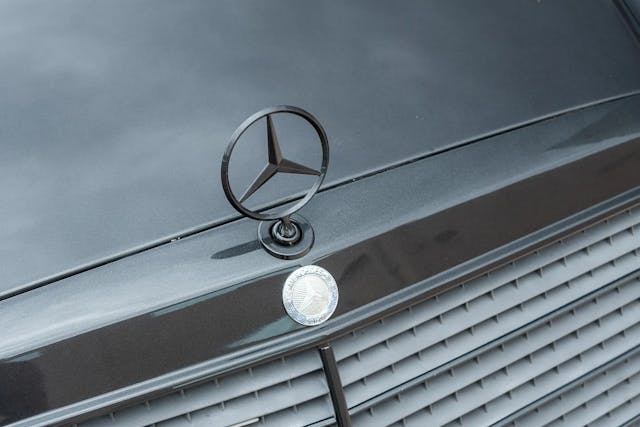Fewer cylinders means easier access to the pre-merger AMG world
Cars from the “greed is good” era are once again raking in the dough, and one only has to look at AMG’s executive bruisers from the late ’80s and early ’90s for proof. Big numbers over the course of the last year, like $775K for a 1987 AMG Hammer Sedan and an eye-watering $885,000 for a 1991 AMG 6.0 Widebody Coupe have shown the market’s renewed enthusiasm for the tuner company’s work from before it was subsumed by Mercedes-Benz.
Fortunately, though, not all these muscular AMGs have become unobtainable, as suggested by this 1991 Mercedes-Benz 300TE 3.4 AMG Wagon, which transacted this week for $65,230 on Bring a Trailer, including fees. We wouldn’t call that affordable, but as a practical, stout, entry-level AMG, it does buy entry to a pretty exclusive club at less than a tenth of the price of those others we mentioned.

Imported from Germany this year and visually not far off from the only AMG 6.0 Hammer Wagon known to exist, this 300TE comes decked out with AMG bodywork, 17-inch monoblock wheels, and a host of factory and AMG options. It certainly looks the part.
While we’re used to seeing AMG coupes and sedans cross the block, it’s not all that often an early AMG wagon makes an appearance. To get a better handle on the car and its sale, we reached out to Jonathan Hodgman, owner of Blue Ridge MB, a shop northeast of Atlanta, Georgia that specializes in AMGs from this era.

Hodgman (who happens to own that Hammer Wagon we mentioned) explained that even though the one that sold on BaT doesn’t have the V-8 power that ’80s and ’90s AMGs are famous for, the company still managed to liven up the car’s personality by sticking to the fundamentals. “It’s just applying basic hot rod principles: added displacement, fatter cams, bigger valves, a little port work. And that’s the root of it,” says Hodgman.
The factory three-liter M104 six-cylinder was rated around 225 hp stock, while AMG’s 3.4-liter put out 276 hp and 245 lb-ft of torque. Not all that big of a difference, but Hodgman notes that the numbers don’t tell the whole story. “Invariably it’s not just the peak power but also the torque under the curve that’s tangible. With that fatter cam, the transition is greater from off-power to on. As a result, the presentation of the power to your brain and your butt, if you will, is more engaging, making it a more fun car to drive.”

Overall, even with around 106,000 miles, this 300TE presents very well, with a near-spotless interior and undercarriage. A stack of service records (they’re in German) and photos of compression tests on all cylinders helped add confidence to the transaction.
Speaking of service, there are a few issues to report about AMG’s six-cylinder cars from this era. Some cars did get an aftermarket Torsen differential that was prone to failure, and head gasket issues were a known problem on the factory and AMG engines. By now, though, most of those issues have been remedied, and the six-cylinder AMG cars are every bit as bulletproof as their more staid standard W124 counterparts. That’s good, since sourcing parts can be a challenge with pre-merger AMGs.

How many of these uprated wagons hit the streets? It’s unclear. “The problem is that there is no official number,” says Hodgman. “The difficulty is that there were so many subcontractors for AMG. You had AMG Japan and the various outlets there. Same thing here in America—you had Westmont, but there were other licensed AMG installers. It was the same in Germany, where this car came from, and Austria and Australia and the U.K. No real records were kept.” Even so, given how infrequently these cars come up for sale, their rarity isn’t in question, and this car’s well-documented history aided in its provenance.
As with just about every corner of the market, cars like this wagon that might be thought of as substitution candidates have jumped in value. Hodgman noted that ten years ago, this 300TE would have been fortunate to fetch 15 grand. He added that he’s observed values of quality standard Mercedes examples of this vintage soften in the last six months, while AMGs have continued to rise. This car’s strong showing appears to confirm Hodgman’s assertion that demand remains strong, at least for the right cars.
Hagerty data backs that up. We’ve begun to keep an eye on ’80s and ’90s AMG models, and while prices are in fact up—sometimes stratospherically so—there’s still significant variance based on provenance and options. Given that outright performance is no longer a real consideration for buyers of these AMGs, this six-cylinder wagon is an appealing and distinctive way to get a piece of Mercedes-Benz tuner history without spending a fortune.
***
Check out the Hagerty Media homepage so you don’t miss a single story, or better yet, bookmark it. To get our best stories delivered right to your inbox, subscribe to our newsletters.



“Vintage AMG”! I need to get used to the sound of that. Missed out on a 1999 E55 sedan for CDN$7500 in 2018 or so, then another for CDN$10K in 2019, and the same price for a wagon that year. I was too far away to snatch two of them, and too slow on the other. More recently, an early C36 was for sale here in Victoria for the same kind of money (these were all rust-free PNW cars with nice interiors and maintenance records), but an autobox with that little engine did not inspire me to pick it up.
AMG V8 Wagon goodness? Yes!